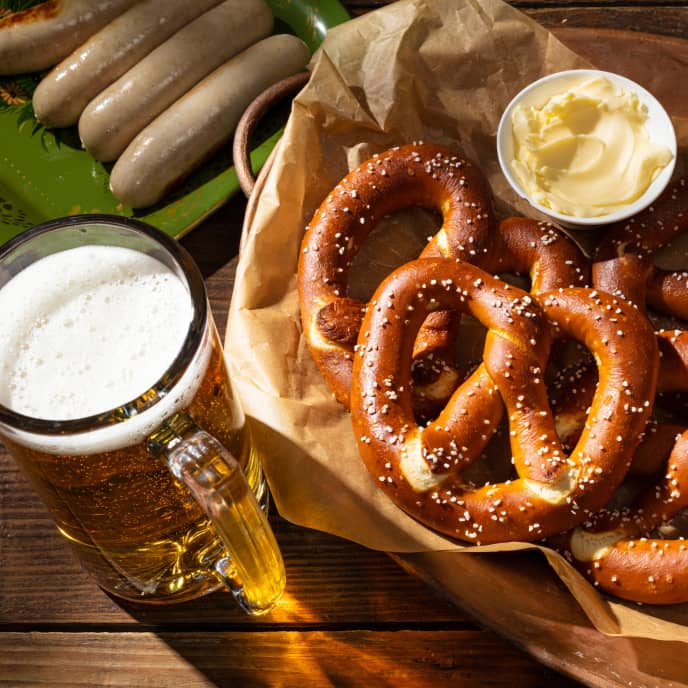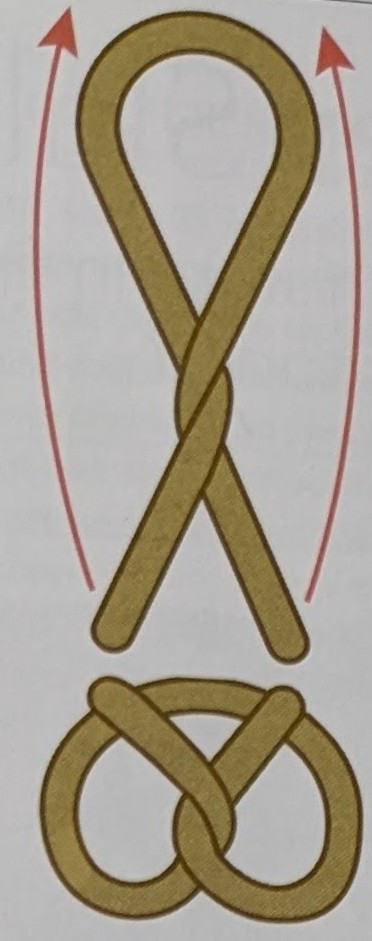 Laugenbrezeln (German Lye Pretzels)
Laugenbrezeln (German Lye Pretzels)

 Serves Serves |  Total Time Total Time |
|---|---|
| 6 | 27 hours |
 Ingredients
Ingredients
2.33 cups bread flour
1 tsp table salt
1 tsp instant yeast
2 Tbsp butter
40 g lye
0.5 cup baking soda
some pretzel salt
 Cookware
Cookware
- 1 stand mixer
- 1 lightly greased bowl
 Instructions
Instructions
Warning
Dipping pretzels in a lye solution before baking gives them their characteristic flavor and texture, but lye is caustic and can be dangerous if used incorrectly. (Lye dipped pretzels are perfectly safe to eat after baking; the heat of the oven neutralizes the alkali.) If dipping in lye, you must read "How to Work with Lye Safely" before proceeding. Alternatively, use the baking soda dip. Food-safe lye and pretzel salt are available at specialty baking shops and online. Kosher salt can be substituted for the pretzel salt, but it will melt more easily. We strongly recommend measuring the flour by weight. This is a great place to use a silicone baking mat, or you can line your baking sheet with parchment paper and coat it very generously with vegetable oil spray. Eat the pretzels plain or like the Germans do: sliced horizontally and spread with butter.
Step 1
Combine bread flour, table salt, and instant yeast in bowl of stand mixer and stir to combine. Add 1 cup room-temperature water and butter. Fit mixer with dough hook and mix on low speed until all flour is moistened, about 1 minute. Increase speed to medium-low and continue to mix until dough is smooth and elastic, about 6 minutes longer, scraping down bowl and dough hook halfway through mixing. Shape dough into ball and transfer to lightly greased bowl. Cover and let rise until almost doubled in size, about 1 hour.
Step 2
Divide dough into 6 equal portions. Working with 1 piece of dough at a time, form into smooth balls. Cover with damp dish towel and let rest for 10 minutes. While dough rests, line rimmed baking sheet with parchment paper.
Step 3
Place 1 dough ball seam side up on unfloured counter and flatten with your hand, pressing out as much air as possible. Using rolling pin, roll out dough to expel remaining air. Stretch and pat dough into roughly 4 by 8-inch rectangle with short side parallel to edge of counter. Starting at short side farthest away from you, roll dough into tight cylinder. Pinch seam to seal. Roll cylinder into 9-inch rope and place under damp dish towel. Repeat with remaining dough balls.
Step 4
Working from center outward, roll first 9-inch rope into 28-inch rope, expelling any lingering air pockets as you go. Shape rope into inverted U with ends facing toward you. Cross rope ends once, and then again. Lift ends and attach them to other side of inverted U at about 10 o'clock and 2 o'clock. Press ends firmly into body of pretzel. Transfer to prepared sheet. Repeat with remaining 9-inch ropes. If pretzels have contracted, stretch each gently and return to sheet. Let sit for 10 minutes, uncovered. Cover with plastic wrap and refrigerate for at least 2 hours or up to 24 hours.
Step 5
Adjust oven rack to middle position and heat oven to 475°F. Line second rimmed baking sheet with silicone baking mat or parchment. If using parchment, spray very generously with vegetable oil spray.
Step 6A
FOR THE LYE DIP: Set up station as directed in "How to Work with Lye Safely." Grasp 1 pretzel with your gloved hands, pinching where ends meet body of pretzel, and transfer gently, presentation side down, to prepared lye bath. Let pretzel soak for 15 seconds, pressing occasionally to submerge. Using your gloved hands, grasp pretzel gently where ends meet body of pretzel and transfer, presentation side up, to prepared wire rack. Repeat with remaining pretzels. With your gloved hands, transfer pretzels to silicone-lined sheet.
Step 6B
FOR THE BAKING SODA DIP: Set wire rack in third rimmed baking sheet. Dissolve baking soda in 8 cups water in Dutch oven and bring to boil over medium-high heat. Reduce heat to simmer. Grasp 1 pretzel with your hands, pinching where ends meet body of pretzel, and transfer gently, presentation side down, to simmering water. Cook for 30 seconds, pressing occasionally with slotted spatula to submerge. Carefully flip pretzel with spatula, then lift with spatula and transfer to prepared wire rack. Repeat with remaining pretzels. Transfer pretzels to silicone-lined sheet.
Step 7
Sprinkle pretzels evenly with pretzel salt. Bake until deeply browned, about 12 minutes. Transfer to second wire rack and let cool for at least 5 minutes before serving.
Technique Do The Twist
After making an inverted U with the dough rope, forming the twist is simple.
- Cross rope ends once, and then again.
- Lift ends and attach them to curve of inverted U at about 10 o'clock and 2 o'clock. Press ends firmly into body of pretzel.

The Truth About Lye
Dunking dough into a strong alkali such as lye is an admittedly curious thing to do, and there are theories as to how this process came about including one of a baker who mistakenly brushed his pretzel with cleaning fluid and decided to just go with it. But the base agent's impact on the dough is actually terrific: It boosts flavorful browning by accelerating Maillardization and caramelizing sugars in the dough. It imparts that unique pretzel smell and taste by inhibiting the creation of typical baked-good aroma compounds while spurring the formation of others and also adds unmistakable mineral flavor. And it gels surface starch, so the pretzels bake up smooth and shiny.
The stronger the alkali, the more intense and impressive the results, which is why German bakers use lye; it features a chart-topping pH of 14 and produces the ultimate pretzel experience. (Rest assured, you're not ingesting a dangerous chemical: The oven's heat completely neutralizes lye and makes it safe to consume.) That said, if sourcing and handling lye isn't for you, you can use a simmering baking soda solution instead. With a pH of roughly 8.3, it reacts less than lye and yields pretzels that are lighter in color and flavor, but the results are still impressive.
How to Work with Lye Safely
Dipping the dough in a lye solution gives traditional German pretzels their characteristic salinity; chew; and smooth mahogany exterior, but the strong alkali (sodium hydroxide) is corrosive and can burn your skin, so it must be handled with caution. (Don't worry about eating it: Baking neutralizes lye and makes it perfectly safe to consume.) Follow this guide to make your experience safe and comfortable.
Lye-Dipping Station Setup
Work in a well-ventilated room, on a stable and roomy counter near an empty sink, if possible. Do not use lye around small children or pets.
Key Supplies
- Food-grade lye (also known as sodium hydroxide), available at baking shops or online
- Long sleeves with long rubber gloves (such as for dishwashing: before wearing, blow up each glove like a balloon to ensure that there are no holes)
- Eyeglasses or safety goggles
- Digital scale that measures in grams
- Rags in case of spills or drips
- Counter protection (plastic wrap or large plastic bag)
Method
- Cover counter with plastic wrap or large plastic bag. Put on rubber gloves, making sure no skin on your arms is showing. Put on eyeglasses or safety goggles.
- Measure out exactly 40 grams of lye crystals into small bowl on scale. Set aside small bowl with lye crystals. Cover container of lye crystals and store in safe location per package instructions.
- Place large bowl on scale. Add 1,000 grams cold water to large bowl. Add reserved 40 grams lye crystals to water and whisk gently to dissolve. Order of operations is important: Always add lye to water instead of adding water to lye. (Lye solution in bowl will heat up slightly and will give off some vapors, which are barely. noticeable, but it's not advisable. to put your face directly over solution.) Rinse whisk well with cool water. Remove scale.
- Set wire rack in rimmed baking sheet and place to right of lye solution. Unwrap sheet of chilled pretzels, place to left of lye solution, and proceed with recipe. (Clear counter while pretzels bake; see below.)
Cleanup
- Still wearing gloves and eyewear, transfer bowl of lye solution to sink.
- Run cold water into bowl in gentle stream to dilute solution. Pour solution down drain. Flush drain and rinse bowl and sink thoroughly with plenty of cold water.
- Rinse rimmed baking sheets and wire rack with plenty of cold water. Dispose of plastic wrap or plastic bag on counter. Rinse gloves before removing. Once gloves are off, remove eyewear.
If Your Skin Touches Lye
Avoid touching anything but the pretzels while working with the lye solution. Before touching something else, rinse your gloved hands with cool water and dry them with rags.
- If you get lye solution on your skin: Rinse your skin immediately with cool running water for 15 minutes.
- If you touch lye crystals: Brush them off with a dry cloth, and then rinse your skin with cool running water for 10 minutes.
 Source
Source
- Cook's Illustrated